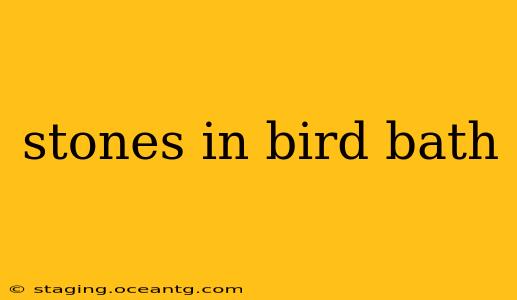Adding stones to your bird bath might seem like a simple addition, but it can significantly improve its functionality and attractiveness to feathered friends. This comprehensive guide explores the benefits, considerations, and best practices for using stones in your bird bath, answering many frequently asked questions.
Why Do Birds Need Stones in Their Bath?
Birds don't need stones in their bird bath in the same way they need food and water. However, stones serve several crucial purposes that enhance the bird bathing experience and encourage more frequent visits. The primary benefit is providing perching spots. Many birds prefer to perch on something while bathing, rather than wading directly in the water. The stones offer a stable, secure place to stand and preen themselves after their bath.
What Kind of Stones Are Best for a Bird Bath?
Choosing the right stones is key. Avoid sharp, jagged rocks that could injure birds' delicate feet. Opt for smooth, rounded river rocks or pebbles. These are gentle on bird feet and offer good stability. The size should be varied – some smaller stones for smaller birds and some larger ones for bigger species. Avoid porous stones that may absorb and retain water, potentially leading to algae growth and contamination.
How Many Stones Should I Put in My Bird Bath?
There's no magic number, but aim for a variety of sizes that cover a significant portion of the bird bath's bottom. You want enough stones to provide ample perching space without overcrowding the bath and hindering the birds' ability to access the water. It's better to start with a moderate amount and adjust based on your observations of how the birds use the bath.
Will Stones Keep My Bird Bath Clean?
Stones themselves won't magically keep the bath clean, but they can help indirectly. By providing perching spots, they reduce the amount of mud and debris birds might track into the water while bathing. Regular cleaning remains crucial to prevent disease and maintain hygiene.
What If My Bird Bath is Too Shallow?
Some bird baths are shallow, making it challenging to add stones without significantly reducing the water depth. In this case, prioritize adding a few larger, flat stones to provide some perching points, even if it means less overall coverage. A shallow bird bath should still offer sufficient water for bathing.
Can Stones Help Prevent Mosquito Breeding?
While stones don't directly prevent mosquito breeding, they can indirectly reduce the breeding sites. A bird bath with many stones will often have less standing water for mosquitoes to lay eggs in. However, regularly cleaning and changing the water remains crucial for mosquito control.
What if I don't have smooth stones?
If you cannot source smooth stones, you can use alternative materials like small, smooth ceramic tiles or even carefully placed pieces of smooth wood. Always prioritize safety and avoid anything sharp or potentially harmful to the birds.
Do stones attract other animals to the bird bath?
While stones primarily benefit birds, they may also attract other small animals, such as insects or frogs. This can be a natural part of the ecosystem around your bird bath and may not necessarily be detrimental. Just make sure to regularly clean your bath to prevent disease from spreading.
Where can I find suitable stones for my bird bath?
Suitable stones can often be found at garden centers, landscaping supply stores, or even collected from clean, natural sources like rivers or beaches (ensure the stones are thoroughly cleaned before use).
By incorporating these tips, you can create a bird bath that's both inviting and functional, providing a welcoming space for your feathered friends to enjoy a refreshing dip. Remember, regular cleaning and fresh water are essential for maintaining a healthy and safe bird bathing area.
